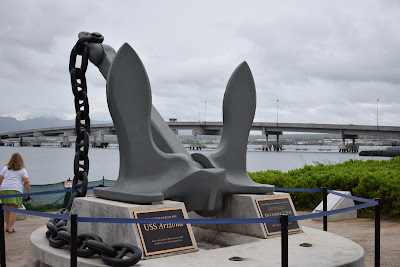I am so grateful we had booked a tour of Pearl Harbor before we boarded the cruise ship. It was the only excursion we could manage and it was well worth it.
By the time 8pm rolled
around after our 9-hour flight, we were falling into bed. It was 2am according to our
body clock. Likewise, we were up very early ready to leave on a tour of Pearl
Harbor at 6am. "Why?" you say? Because that's when the tour bus told
us to be, is our only answer! In retrospect, it was a great plan because we were
up at 4am anyway. (That whole Body-Clock thing again!) I suspect the local tours
try to be done early because the cruise ships coming in would have inundated
the Memorial site later in the day.
We were warned in advance to leave everything in the hotel and bring only ID, a camera and/or a cellphone. Anything else would have to be left in a locker at the gate. No bags allowed.
Once through security visitors could purchase tickets to tour the different sites, as well as recorded headsets that explained some of the displays. I am very glad we got the headsets.
Although the Memorial
site houses a battleship, the USS Missouri, and a submarine, the USS Bowfin,
the most popular attraction is the memorial for the USS Arizona. Four ships were sunk during the attack on Dec. 7, 1941. All
except the Arizona were able to be salvaged, repaired and participate in
defending our country during WWII. The Arizona took four direct hits from Japanese
bombs, and the explosions from the munitions on board helped to sink her before
most of her 1177 sailors could escape. Only 75 sailors survived. It was the
single greatest loss of life on any ship.
Upon our arrival, we were assigned a time to be in line to board the tender. We viewed a brief movie giving a history of the attack before we went out to the Arizona. Meanwhile, there were exhibits to view, from Pre-War to Post-Attack.
The exhibits covered the political climate in Asia, mostly Japan, and the United States that led up to the attack; the battleships in use, the introduction of Radar, and life in Hawaii following the attack.
Two things were a direct result of WWII. First of all, the military realized that Radar was not just a new toy, but an important tool. Secondly, In WWI, battleships were the strength of the military, but aircraft became of paramount importance during WWII.
We boarded a tender that took us out to the white low-slung building with the big windows in the side; the memorial to the USS Arizona. Our guide explained the concept behind the design. The memorial rises on both ends above a sagging center. The concept embodies the height of American pride, the depression after the attack, and the rise of American power. There are 7 portholes on each side and in the ceiling; 21 portholes representing a 21-gun salute.
The memorial is built over the ship, but perpendicular to it. As you stand within and look out a porthole you can see exposed parts of the ship resting beneath you.
 |
Viewed from a porthole, the base of a gun turret is visible above water.
|
Looking through the hole in the floor you can easily see the base of a gun turret just under the water. It is eerie looking down and seeing the ship directly below you.
Survivors of the attack have asked to have their ashes returned to the ship. A diver takes the ashes and places them into the turret. One diver said "When I place the ashes into the turret I can feel a slight tug. It's as if the ship is welcoming them home."
In the distance viewers can see where the Battleship, USS Missouri, is moored. The Missouri is the ship on which the Japanese surrendered.
Standing on the Arizona memorial, and looking down, I could see the oil slick that constantly bubbles up from the ship's hold. It drifts toward the Missouri.
One end of the memorial building houses the Shrine Room. The Shrine Room lists the names of the casualties from the Arizona. Standing on the Arizona memorial, and looking down, I could see the oil slick that constantly bubbles up from the ship's hold. It drifts toward the Missouri.
There is a marble bench on each side of the room listing the survivors who requested their ashes be returned to the ship. The wall on both sides of the room contains the sculpture, The Tree of Life, representing Life Survives, Renews, Goes On.
Pearl Harbor means many things to many people. It is a remembrance to the time a small power "awoke the sleeping giant". It is a testament that we will never give up. It is a reminder that Life will go on. It is a remarkable place to visit.





















No comments:
Post a Comment